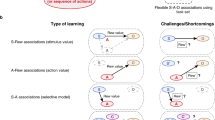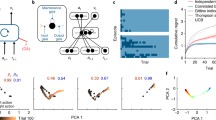Abstract
Our goal is to develop cognitive agents based on neuroscientific evidence. The efficiency of cognitive behavior depends on its capacity to select, represent and manipulate sufficient knowledge of the environment to achieve its goals. We designed a biologically motivated model of basal ganglia and particularly the prefrontal cortex and here review its foundations of neural learning and summarize our obtained results.

Similar content being viewed by others
References
Abraham WC (2008) Metaplasticity: tuning synapses and networks for plasticity. Nat Rev, Neurosci 9:387–399
Baddeley A (2003) Working memory: looking back and looking forward. Nat Rev, Neurosci 4:829–839
Clopath C, Ziegler L, Vasilaki E, Buesing L, Gerstner W (2008) Tag-trigger-consolidation: a model of early and late long-term potentiation and depression. PLoS Comput Biolol 4:e1000248
Cohen MX, Frank MJ (2009) Neurocomputational models of basal ganglia function in learning, memory and choice. Behav Brain Res 199(1):141–156
Eggert J, Wersing H (2009) Approaches and challenges for cognitive vision systems. In: Creating brain-like intelligence: from basic principles to complex intelligent systems. Lecture notes in computer science, vol 5436. Springer, Berlin, pp 215–247
Frégnac Y et al. (2010) A re-examination of Hebbian-covariance rules and spike timing-dependent plasticity in cat visual cortex in vivo. Front Synaptic Neurosci 2:147
Frey U, Morris R (1997) Synaptic tagging and long-term potentiation. Nature 385:533–536
Haber SN (2003) The primate basal ganglia: parallel and integrative networks. J Chem Neuroanat 26:317–330
Helie S, Sun R (2010) Incubation, insight, and creative problem solving: a unified theory and a connectionist model. Psychol Rev 117:994–1024
Langley P, Laird JE, Rogers S (2009) Cognitive architectures: research issues and challenges. Cogn Syst Res 10:141–160
Turrigiano GG, Nelson SB (2004) Homeostatic plasticity in the developing nervous system. Nat Rev, Neurosci 5:97–107
Oja E (1982) A simplified neuron model as a principal component analyzer. J Math Biol 15:267–273
Schroll H, Vitay J, Hamker FH (2012) Working memory and response selection: a computational account of interactions among cortico-basal ganglio-thalamic loops. Neural Netw 26:59–74
Schultz W (1998) Predictive reward signal of dopamine neurons. J Neurophysiol 80:1–27
Stocco A, Lebiere C, Anderson JR (2010) Conditional routing of information to the cortex: a model of the basal ganglia’s role in cognitive coordination. Psychol Rev 117:541–574
Trapp S, Schroll H, Hamker FH (2012) Open and closed loops: a computational approach to attention and consciousness. Adv Cogn Psychol 8:1–8
Vernon D, Metta G, Sandini G (2007) A survey of artificial cognitive systems: implications for the autonomous development of mental capabilities in computational agents. IEEE Trans Evol Comput 11:151–180
Vernon D, Metta G, Sandini G (2010) Enaction as a conceptual framework for developmental cognitive robotics. Paladyn J Behav Robot 1:89–98
Vitay J, Fix J, Beuth F, Schroll H, Hamker FH (2009) Biological models of reinforcement learning. Künstl Intell 3:12–18
Vitay J, Hamker FH (2010) A computational model of the influence of basal ganglia on memory retrieval in rewarded visual memory tasks. Front Comput Neurosci 4:13
Wiltschut J, Hamker FH (2009) Efficient coding correlates with spatial frequency tuning in a model of V1 receptive field organization. Vis Neurosci 26:21–34
Acknowledgements
This project report provided an overview of recent research on neural learning of cognitive control in our lab which involved contributions from multiple researchers, particularly from Henning Schroll, Julien Vitay and Jan Wiltschut.
This work has been funded by DFG HA2630/4-1 and HA2630/4-2 as well as by the EU FP7-ICT program “Eyeshots: Heterogeneous 3-D Perception across Visual Fragments”.
Author information
Authors and Affiliations
Corresponding author
Rights and permissions
About this article
Cite this article
Hamker, F.H. Neural Learning of Cognitive Control. Künstl Intell 26, 397–401 (2012). https://doi.org/10.1007/s13218-012-0210-7
Published:
Issue Date:
DOI: https://doi.org/10.1007/s13218-012-0210-7




